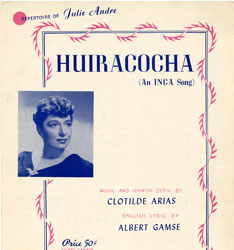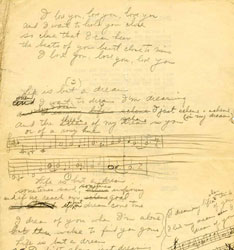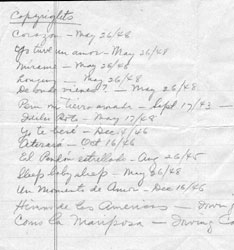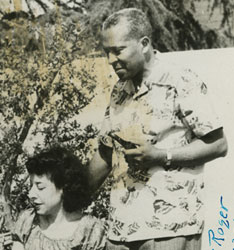
Huiracocha
Huiracocha, one of the most important deities in the Inca pantheon, was seen as the creator of all things, or the substance from which all things are created, and intimately associated with the sea. Huiracocha created the universe; the sun, moon, and stars; time; and civilization itself.
This 1941 composition by Clotilde Arias pays tribute to this all-powerful god and is her way of giving a special place to the indigenous people of the Americas, especially of the Andes and Peru. “Huiracocha” is an exaltation and a kind of lament. Arias considered herself an expert in Inca music and composed many songs in its style.
Arias’s scribble paper reveals her work and thought processes. There are notations, music lyrics, actual music, and comments to herself. During her forty-year career she secured a copyright on more than eighty of her songs, and became a member of ASCAP—the American Society of Composers, Authors and Publishers, which protects musicians’ performance rights.
Clotilde Arias’s social and professional networks were extensive. Here we get a glimpse of the wide variety of people she associated with and how important they were in her life.
My soul is empty, Huiracocha, my Father. In the cold mornings of vast mountains, I play my wooden flute, I play my wooden flute.
Clotilde Arias, “Huiracocha”
Huiracocha, uno de los dioses más importantes del panteón inca se considera como el creador de todo el Universo y está estrechamente vinculado con el mar. Huiracocha creó el Universo, el sol, la luna, las estrellas, el tiempo y la civilización misma.
Esta composición de 1941 por Clotilde Arias es un homenaje a este dios y es su manera de colocar a todos los pueblos indígenas de las Américas en un lugar especial, en particular a los pueblos de los Andes y del Perú. “Huiracocha” es una exaltación y una especie de lamento. Arias se consideraba experta en la música incaica y compuso muchas canciones en ese estilo.
Los apuntes de Arias revelan su trabajo y sus procesos de pensamiento. Se componen de anotaciones, letras de canciones, música y comentarios para ella misma. A lo largo de su carrera de cuarenta años, obtuvo los derechos de autor para más de ochenta de sus canciones. Perteneció a la Sociedad Americana de Compositores, Autores y Editores de Música (ASCAP), que protege los derechos de ejecución de los músicos.
Las redes sociales y profesionales de Clotilde Arias eran extensas. Esta sección es una pequeña ventana donde podemos ver la gran variedad de gente con la que ella se asociaba y lo importante que fueron en su vida.
Y en mi alma hay un vacío, Huiracocha, Padre mío. En las mañanas frías de vastas serranías yo voy cantando mi quena, yo voy cantando mi quena.
Clotilde Arias, “Huiracocha”
This group picture shows Clotilde Arias with two greats of mid-20th-century New York: María Grever (far left), and James Michener (far right), with Clotilde in the middle. Grever was the premier female composer of Mexico, who spent much of her life in New York and composed more than 850 songs, including “What a Difference a Day Makes” in 1934. Michener became a prolific writer of bestsellers, starting with Tales of the South Pacific in 1947. He and Arias were good friends and colleagues at Macmillan Publishers at the time of this photograph.
This photo originally appeared in Movie-Radio Guide for March 16 22, 1942. The caption reads: “Clotilde Arias, distinguished Peruvian composer, shows Terig Tucci, brilliant Argentina composer and conductor, the score of her orchestral work which will be transmitted this month in celebration of Amazonic Anniversary. Señor Tucci is music director of Columbia’s Latin American network.”
Arias’s scribble paper reveals her work and thought processes. There are notations, music lyrics, actual music, and comments to herself.
During her forty-year career she secured a copyright on more than eighty of her songs, and became a member of ASCAP—the American Society of Composers, Authors and Publishers, which protects musicians’ performance rights.






